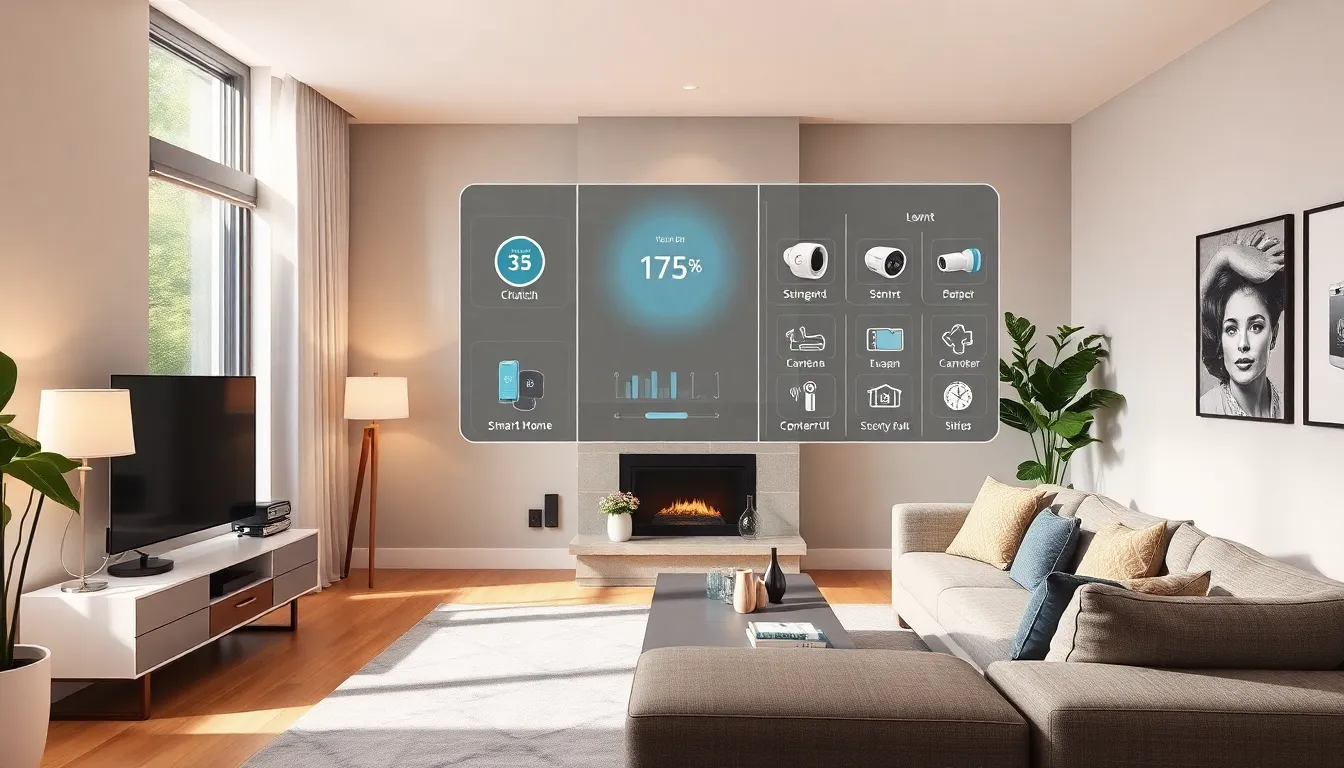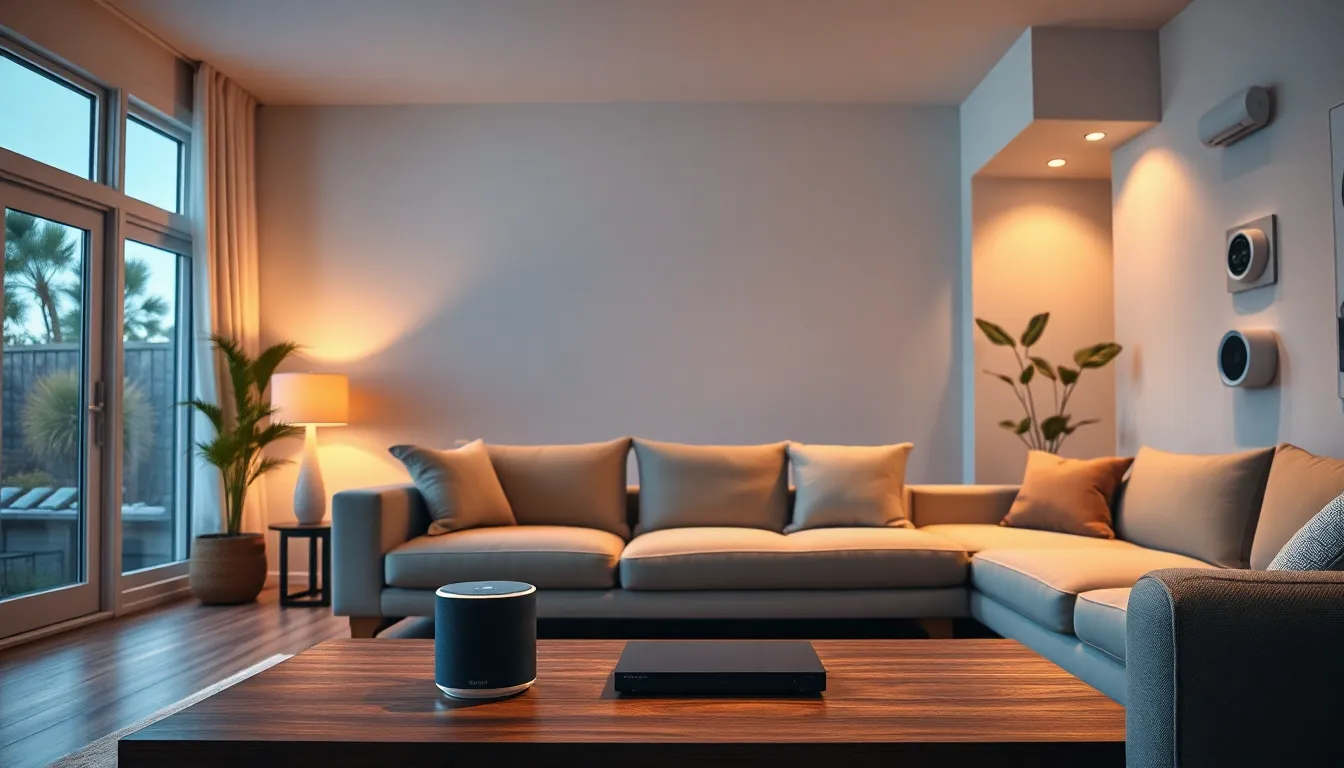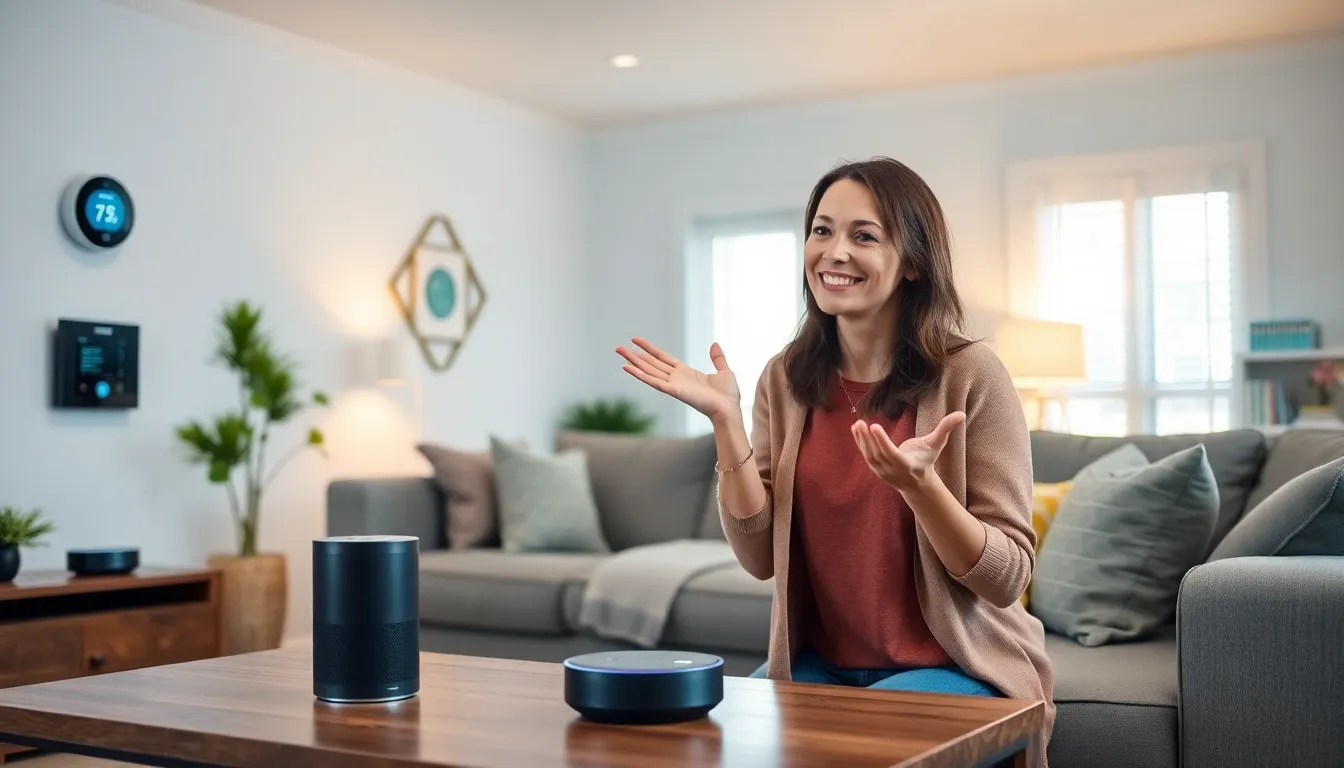Imagine walking into your home and having it greet you like an old friend. Smart home solutions are transforming houses into interactive spaces that respond to your every whim. From lights that dim at your command to thermostats that know just how warm you like it, these gadgets are designed to make life easier and a bit more fun.
Table of Contents
ToggleOverview of Smart Home Solutions
Smart home solutions integrate technology to enhance everyday living. These systems connect devices through the internet, allowing remote control and automation. Popular options include smart lighting, thermostats, security cameras, and voice assistants.
Smart lighting offers convenience and energy savings. Users can schedule lights to turn on or off at specific times, or control brightness and color remotely. Thermostats learn personal habits. They optimize heating and cooling based on preferences, resulting in energy efficiency.
Security is a major consideration. Smart security cameras provide real-time monitoring and alerts, ensuring peace of mind. Users can access feeds via smartphones, allowing them to check their homes from anywhere.
Voice assistants streamline interactions. Devices like Amazon Echo and Google Home enable hands-free control of all connected elements. Users can issue commands to create routines tailored to their daily activities.
The interoperability of devices adds to the appeal. Many smart home solutions sync with platforms like Apple HomeKit, SmartThings, and IFTTT. This integration simplifies setup and enhances functionality across brands.
Data privacy remains a concern. Manufacturers implement encryption and regular updates to safeguard user information. Awareness of these issues guides consumers to make informed decisions when selecting smart technology.
Ongoing advancements in artificial intelligence and machine learning drive innovation in smart home solutions. As these technologies evolve, homes become more responsive to user needs, creating a seamless and enjoyable living experience.
Benefits of Smart Home Solutions

Smart home solutions offer numerous advantages, enhancing the overall living experience. Their integration leads to improved safety, reduced energy consumption, and increased comfort.
Enhanced Security
Smart home security devices provide real-time monitoring and alerts. Cameras can record footage, allowing homeowners to check on their property remotely. Motion sensors trigger notifications if unexpected movement occurs, increasing awareness. Smart locks enable users to grant access remotely, eliminating the need for physical keys. Benefits include peace of mind, particularly when away from home. Many security systems integrate seamlessly with other smart devices, creating a comprehensive safety network.
Energy Efficiency
Energy-efficient smart solutions optimize resource use effectively. Smart thermostats adapt to user habits, learning when to adjust temperatures for maximum efficiency. Lighting systems can be scheduled or controlled remotely, reducing unnecessary energy consumption. Appliances equipped with smart technology enable users to track usage, promoting conscious energy management. Overall, these systems lead to significant cost savings on utility bills while reducing the carbon footprint.
Convenience and Comfort
Convenience becomes a hallmark of smart home solutions. Voice assistants facilitate hands-free control of various devices, including lights, thermostats, and entertainment systems. Automated routines adjust settings based on user preferences, making daily tasks simpler. Control of multiple devices from a single app streamlines interactions, minimizing time spent on managing homes. Comfort levels rise as environments adjust automatically to meet individual tastes and needs.
Popular Smart Home Devices
Smart home devices enhance convenience, security, and efficiency. Users can take advantage of a variety of popular options tailored to fit their needs.
Smart Lighting
Smart lighting systems offer flexibility in home illumination. Users control lighting remotely or through voice commands. Some systems adapt brightness and color based on the time of day, contributing to a pleasant atmosphere. Energy-efficient LED bulbs commonly feature in these solutions, reducing electricity consumption. Additionally, users can set schedules or automate lights based on occupancy, ensuring energy savings and convenience. Brands like Philips Hue and LIFX provide widely recognized smart lighting options.
Smart Thermostats
Smart thermostats learn user behavior to optimize indoor climate control. These devices can automatically adjust heating and cooling based on comfort preferences and occupancy patterns. Features like remote temperature adjustments add convenience for homeowners. Many smart thermostats integrate with weather forecasts to further enhance energy efficiency. Nest and Ecobee are popular options that offer intuitive interfaces and robust energy-saving capabilities. By personalizing heating and cooling schedules, users experience lower energy bills and increased comfort.
Home Security Systems
Home security systems integrated with smart technology enhance protection against intrusions. Users benefit from real-time alerts and 24/7 monitoring through mobile applications. Most security cameras include motion detection and night vision capabilities for comprehensive coverage. Many systems support integration with existing smart devices, allowing users to create tailored security routines. Notable brands like Ring and Arlo offer advanced features, such as facial recognition and two-way audio. These systems provide peace of mind, knowing homes are safeguarded even when occupants are away.
Integrating Smart Home Solutions
Integrating smart home solutions transforms ordinary living spaces into adaptable environments. This process requires careful selection and setup of devices for optimal functionality.
Choosing the Right Ecosystem
Selecting an ecosystem is crucial for seamless integration of smart home devices. Popular ecosystems include Apple HomeKit, Google Home, and Amazon Alexa. Each offers distinct functionalities and compatible devices. Apple HomeKit prioritizes user privacy and security, making it appealing for those concerned about data protection. Google Home provides robust voice interaction with excellent search capability, while Amazon Alexa boasts a vast array of compatible devices and third-party integrations. Determining which ecosystem aligns with individual needs simplifies device selection and enhances user experience.
Installation and Setup Tips
<a href="https://atwillowpond.com/home-automation-system-installation“>Installation plays a significant role in maximizing smart home device functionality. Start by ensuring a reliable Wi-Fi network that can support multiple devices. Position smart devices within range of the router to maintain strong connections. Consult manufacturer instructions for specific installation guidelines, as setups often vary between devices. Using mobile apps can streamline the setup process while guiding through device configuration. Finally, grouping devices into rooms on the app facilitates easier control and automation, creating an organized smart home environment.
Future Trends in Smart Home Technology
Advancements in smart home technology continue to evolve rapidly. Voice control capabilities are expanding, allowing devices to respond to more natural speech patterns. Automation systems are now capable of learning user preferences, adapting heating and lighting based on behavior patterns.
Integration with artificial intelligence is another key trend. Smart devices analyze data to improve efficiency and performance, leading to more personalized experiences in everyday living. Enhanced home security features are typically equipped with real-time monitoring and facial recognition, providing users with comprehensive protection.
Consumers increasingly prioritize energy efficiency, prompting manufacturers to develop sustainable devices. Smart thermostats and energy-efficient lighting solutions are designed to optimize usage, significantly reducing energy bills. Moreover, the popularity of interconnected ecosystems drives demand for devices that seamlessly communicate with one another.
Home automation systems now provide remote access via smartphones, enabling users to control multiple devices even while away from home. Cloud-based services allow for continuous software updates, ensuring devices remain secure and up-to-date. In addition, voice assistants are becoming more integrated into various home appliances, enhancing user control and convenience.
Compatibility with various platforms is crucial for today’s consumers. Manufacturers focus on ensuring that smart home devices integrate smoothly with popular ecosystems like Google Home, Amazon Alexa, and Apple HomeKit. This adaptability streamlines device management, making it easier for users to create cohesive automated routines.
Emerging technologies, including 5G connectivity, promise to enhance smart home capabilities further. Faster data transfer rates will lead to improved response times and better overall performance of connected devices. As these trends continue to unfold, the future of smart home technology looks promising, presenting new possibilities for comfort, convenience, and security.
Smart home solutions are revolutionizing the way people interact with their living spaces. By integrating advanced technology into everyday life, these devices enhance convenience, security, and energy efficiency. The ability to control everything from lighting to temperature remotely not only simplifies daily routines but also promotes a more sustainable lifestyle.
As consumers continue to seek out innovative ways to improve their homes, the demand for smart solutions will only grow. With ongoing advancements in artificial intelligence and connectivity, the future of smart homes promises even greater convenience and personalization. Embracing these technologies can lead to a more enjoyable and secure living environment, making smart home solutions an essential part of modern life.





